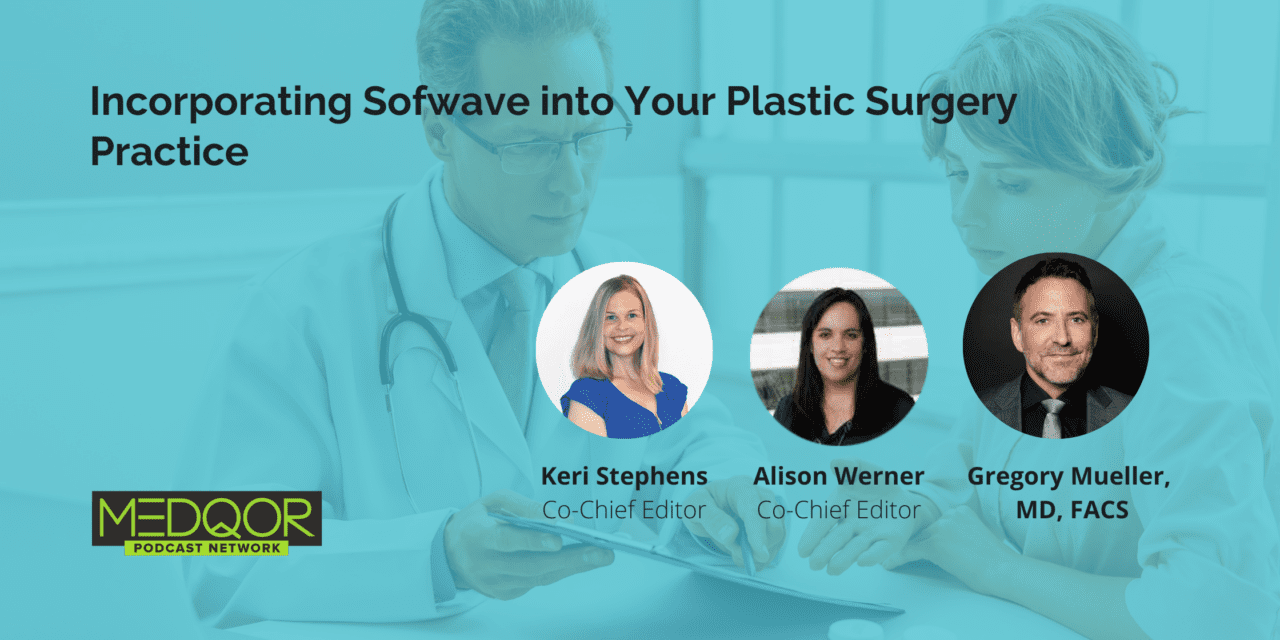Join Plastic Surgery Practice Co-Chief Editors Alison Werner and Keri Stephens as they talk to Los Angeles-based, board-certified plastic surgeon and inventor Gregory Mueller, MD, FACS, about a trending device in aesthetic medicine. A public speaker who educates surgeons about the minimally evasive MyEllevate procedure that he developed, Mueller discusses another technology in this podcast: the Sofwave energy-based device, which he uses in his practice.
In December, the U.S. FDA cleared Sofwave to treat the appearance of cellulite, complementing its previous clearances to lift the eyebrow lax submental tissue as well as neck tissue. Here, Mueller reveals how Sofwave is different from other devices on the market, in addition to which patient population Sofwave benefits most. He also shares what the learning curve is like for using Sofwave, along with his advice about the device to his plastic surgeon peers.
Podcast Transcript
Keri Stephens:
Hello and welcome to the Plastic Surgery Practice Podcast, a part of the MEDQOR Podcast Network. My name is Keri Stephens and today I’m joined by my co-chief editor, Alison Werner.
Today we are talking to Dr. Gregory Miller, a world renowned inventor and Los Angeles-based board certified plastic surgeon. Dr. Miller is also a Diplomat of the American Board of Plastic Surgery, a fellow of the American College of Surgeons and a public speaker who educates surgeons around the world about the minimally evasive MyEllevate procedure that he developed.
But today we wanted to talk to Dr. Miller about something different and how he’s using one aesthetic device SoftWave. Dr. Miller, thank you for joining us today.
Dr. Gregory Mueller:
Thank you for having me. I’m excited to talk to you about SoftWave today.
Keri Stephens:
We’re excited to learn about it. So to start, what exactly is SoftWave and how are you using it in your practice?
Dr. Gregory Mueller:
Sure, sure. So just a little bit of background. I’m a plastic surgeon and I’ve been practice in Beverly Hills since 1998 and I love doing surgery, right? So that’s kind of my thing.
But I know that every patient who walks through the door doesn’t want to have surgery and maybe they don’t need it as well. So I’m always looking for great technologies that can do sort of what I do without the knife.
SoftWave is an amazing technology because it uses ultrasound energy and we actually do it here in the office. We literally put some numbing cream on and then some gel, and then we just pass this transmitter over the skin and it heats the skin and causes some reduction of fine lines and wrinkles; also lifts a little bit under the chin and lifts a little bit of the brow without surgery. So it’s just great for somebody who’s a little bit younger who wants to have a refreshed look and a little bit of lifting and so on.
Alison Werner:
So tell me, how is SoftWave different than other devices on the market?
Dr. Gregory Mueller:
Yeah, so there are a lot of different devices on the market. There’s such a drive these days to find something that is non-surgical, to make people look younger and to also sort of restore that younger collagen that we had in our twenties. And so there are many devices out there.
SoftWave is different for many reasons. Number one, which I think is really cool. And the patients love this as well. There are no needles with SoftWave. SoftWave is just done on the top of the skin. We joke about it sometimes it’s almost like ironing your skin, but of course without the heat like an iron, but it just passes over the skin so there’s no needle sticks, so no bruising.
It uses ultrasound energy and that energy, the design that the engineers did is really genius because when it delivers the energy, the ultrasound stays right in the skin so it doesn’t go any deeper. So you don’t have any melting of fat.
There were other technologies in the past that I never purchased because they would melt fat. This one stays right in the skin, so it does exactly what you want it to do. It tightens the skin and it does some really nice lifting under the chin. It can actually give patients a little bit of a brow lift, which is amazing without surgery. And also it’s just great for fine lines and wrinkles. So it’s just such a good workhorse.
And we use it all around the face. We use it on the neck area, but we also use it off-label around the tummy area, above the knees, upper arms. So just think of the areas where people have a little fine lines and wrinkles or little skin laxity. It kind of works anywhere on the body.
Keri Stephens:
So let’s talk patients now. Who is the ideal patient for SoftWave? I mean, is it a younger patient? I mean, if you could create the perfect SoftWave patient, who would it be?
Dr. Gregory Mueller:
Yeah, so the perfect SoftWave patient really is anyone who looks in the mirror and starts seeing a little bit of aging, some sagging skin, some fine lines and wrinkles, or they have some wrinkles on their skin really anywhere on the body and would like to have some toning of that skin or little lifting under the chin or maybe a little bit of lifting of the eyebrow. Those are all great candidates for SoftWave.
So as a plastic surgeon, I do a lot of facelifts and neck lifts. So I love using SoftWave as a way to prolong the results. So when we do a facelift or neck lift, we sort of reset the aging clock and then life has it as it does, and the clock starts moving forward. So patients start getting a little bit of sagging under the chin after a year or so.
So we use SoftWave to help restore their results, to help lift the area of the skin under the chin, to help with fine lines and wrinkles. Also just help reduce the fine lines and wrinkles around the eyes and also lift the brows a little bit.
So we use it as a prolongation procedure to help our patients have longer lasting results with facelifts and neck lifts.
Alison Werner:
So you mentioned just now that for patients who have had facelifts and neck lifts, that you kind of had them come in every six months to kind of have that rejuvenation of the procedure, to keep the lasting effects going.
For someone who’s not having a facelift or lift or a neck lift and is just coming in for SoftWave, how often do they need to come in to either maintain results or just to tweak? Or how often do people come in for a SoftWave treatment?
Dr. Gregory Mueller:
Sure, that’s a great question. And just like everything that we do, even if I do a major surgery, it doesn’t last forever. So SoftWave is the same way. SoftWave, what it does, it works by heating the skin, creating a very controlled injury to the collagen and elastin, and then the body responds by placing new collagen and elastin in the skin and it also causes the skin to become a little bit thicker. All of those are attributes of younger skin like we all had when we were in our twenties.
So when a patient comes in and they just want a non-surgical solution, then what our treatment program is with SoftWave is we’ll have them get a treatment when they come in. And then if they’re a little bit older, maybe older than say 40, 50 years old, then we’ll repeat it in one month and then we recommend every year, maybe every six months after that.
I think here in Beverly Hills with our patients, we have a lot of them who are in front of the camera or are in big positions where they’re in front of large groups of people. Those folks may come in every six months because they want to really keep their looks looking great, whereas people who aren’t in front of the camera, they may come in once a year.
Alison Werner:
Now after patients had the procedure, what has been your experience with their satisfaction with SoftWave and its results?
Dr. Gregory Mueller:
Yeah, SoftWave is one of the many treatments we offer here at my office. And the other ones that I offer are things like surgery, like we talked about. But also we do things like neurotoxins to relax muscles. We all know about those. And we also use things like fillers to help fill up wrinkles and things like that.
We also use microneedling here as well, which is a popular treatment to help just the surface of the skin and the pore sizes and so on. But SoftWave I’ve had now for over a year, and it’s our most popular procedure.
So when people ask me how successful is it, I tell them, we have so many different levels of care here, but SoftWave is our number one utilized treatment here in the office. So that says a lot about it.
Keri Stephens:
So when you have SoftWave, do you combine SoftWave with other minimally evasive treatments at the same time usually?
Dr. Gregory Mueller:
Most patients who come in today have multiple levels of treatment. Everyone, especially today, is very educated about different solutions for the aging process.
So what we do is we combine SoftWave with other treatments. And I would say probably the most common one is we use a radiofrequency microneedling device. And what we do is we use SoftWave as our lifter to kind of lift the area under the chin to help with fine lines and wrinkles in the brow. And then we use microneedling with RF to just help with the skin surface itself. We also combine it with fillers and also neurotoxin and things like that.
Alison Werner:
Let’s talk to your peers at this point. Well, we’re talking to them anyways, but how are you marketing SoftWave to your patients and potential patients in your practice?
Dr. Gregory Mueller:
SoftWave’s an easy sell for us. So we have patients who will come in and they’re willing to share their experience of having the treatment on social media. We also refer patients to the SoftWave website, which is very nicely done and has multiple patients from many different doctors around the country. That’s a very powerful message because if you see something that works in multiple doctor’s hands, that’s a great bit of credibility to the technology.
So I would say just showing people before and after results that are available online. And then also on social media, it’s a pretty popular procedure. So patients sometimes will see something on social media and they’ll call us and say, “Hey, do you have SoftWave?” And so, we do. So it’s out there. People are really excited to learn about it.
Alison Werner:
Oh, that’s good. Okay. And so for you, when you first brought the technology into your practice, what was the training or the learning curve there? What do you recommend to your peers who are thinking of adopting this?
Dr. Gregory Mueller:
SoftWave technology is really elegantly designed, and it’s simple. We have many devices out there that require a lot of training, and there’s just a lot of adjusting that the surgeon has to do or the provider, the extender.
SoftWave is super easy. And the great thing is the safety profile is really, really, it’s really solid. So the training, a nurse comes in or one of the trainers I guess from the company. They show us the technology and then we treat several patients and the learning curve is really fast.
Keri Stephens:
So as a last question just to wrap this up, what are your patients that come to you for SoftWave most concerned with? For instance, your neck, the jawline, the eyes?
Dr. Gregory Mueller:
I would say that most of our patients who come in are concerned about the early signs of aging that they see along the jawline and the neck area. The neck area is always a challenging area to treat aging because the skin is thinner in our neck region. Then along the jawline we tend to get some fat deposits that are called jowls, and so people don’t like those. And then under the chin, things tend to start drooping a little bit. So I would say those in my practice are the number one indications.
And then the midface area, people start noticing some fine lines and wrinkles and just some drooping of the soft tissues to the face. So it’s just a great way to kind of rejuvenate patients who have that and just make the skin look so much better.
Keri Stephens:
No, that’s great. Well, thank you so much Dr. Miller. This was very informative and I’m sure it was to our listeners, too.
And to our listeners, be sure to check back soon on the MEDQOR Podcast Network for the next episode of the Plastic Surgery Practice Podcast.
And in the meantime, to catch up on the latest industry news, please check out plasticsurgerypractice.com.
Until next time, take care.





